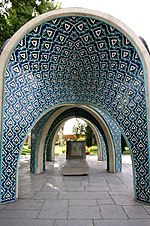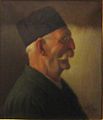Kamal-ol whey
Mohammad Ghaffārī Kāschānī ( Persian محمد غفاری کاشانی, DMG Moḥammad Ġaffārī Kāšānī ), known under the name Kamāl-ol-Molk (کمالالمُلک Kamāl al-Molk ; * 1847 in Kashan ; † 1940 in Nischapur ), was an Iranian painter and is considered a pioneer of modern art in Iran.
Life
Young years and work at the court of Naser al-Din Shah
Kamāl-ol-Molk was born into an important and influential family of artists. His uncle Mirzā Abol Hassan Chān Ghaffari was famous as a miniature painter and his father Mirzā Bozorg Ghaffari Kāshāni founded the Iranian School of Painting.
After finishing primary school, Kamāl-ol-Molk went to Dar-ol Fonun School in Tehran . Here he made such great progress that he was appointed court painter to Nasreddin Shah's court at the age of 18 . As a token of appreciation for his perfection, the latter gave him the title Kamāl-ol-Molk , under which he continued to be known. During his time at the court of Nasreddin Shah, he mainly created portraits, landscape paintings, depictions of Persian court musicians, royal hunting grounds and various parts of royal palaces. Kamāl-ol-Molk was characterized above all by his fine brushwork and his preference for bright and lively colors.
In-depth studies in Europe
In 1898, at the age of 49, Kamāl-ol-Molk went to Europe to study in greater depth at the Louvre in Paris , Versailles and Florence . There he spent four years, during which he came into contact with important artists. He devoted his studies to the works of Rembrandt van Rijn , Raphael , Titian and Leonardo da Vinci . However, it was here that he primarily learned the principles of realistic art .
In 1902 he met Mozaffar ad-Din Shah in Paris, who invited him to return to Iran. Kamāl-ol-Molk accepted the invitation and also painted a portrait of Mozaffar ad-Din Shah. His new, realistic style did not seem to have been in great demand at the court of Mozaffar ad-Din Shah, so that he left Iran again in 1903 and traveled through the Ottoman province of Mesopotamia (today's Iraq ). Inspired by the new environment, he created some of his most famous works here, such as the fortune teller of Baghdad ( Fālgīr-e Baghdād ), the goldsmith of Baghdad and his pupil ( Zargar-e Baghdād wa Shāgerd-asch ), the Kerbala Square ( Meidān- e Karbalā ) and the Sleeping Arab ( Arab-e Khofteh ).

Establishment of the Kamāl-ol-Molk Art School
The outbreak of the Constitutional Revolution in Iran prompted Kamāl-ol-Molk to return to Iran again. The increased esteem he was now accorded as an artist helped him found his Sanaye Mostazraf or Kamāl-ol-Molk art school , which was to play an important role in modern art in Iran. The aim of this school was to promote new talents in the best possible way and to attract talented students within the shortest possible time. Many of his students later became famous artists themselves: for example, Hossein Ali Khan Vasiri, Mohsen Soheili, Esmail Ashiani and many more. In addition to painting, the school also taught carpet weaving, mosaic design and woodwork.
Kamāl-ol-Molk devoted part of his own salary to promoting poor students. In 1927 he lost an eye in an accident. He gave up the management of his art school and retired to Hossein Ābād, a village near Nishapur . He rarely painted anymore. In 1933 a painting of the newly erected Firdausi statue was created and in 1935 he painted a landscape study and the painting Sleeping Old Man .
Kamāl-ol-Molk died in 1940. He was buried in Nishapur next to the Sufi poet Attar .
plant
Kamāl-ol-Molk was an extremely prolific painter. However, many of his countless works have been destroyed or in private collections, making them no longer accessible to the public. What remains are works from the Tehran Museum of Contemporary Art , the National Consultative Assembly , the Golestan Palace and other museums and art centers. In addition to watercolors and sculptures, it is mainly his oil paintings that he is known for.
His most famous works include, besides those already mentioned above, the Twin Waterfalls (The Twin Waterfalls) (1882), the Golestan Palace (1883), Emāmeh Village (The Emāmeh Village) (1884), Bāgh-e Shah ( The King's Garden ) (1886 ), Zanoosi Valley (The Zanusi Valley) (1886), Government Camp (The Government Camp) (1889), The Goldsmith , Two Begging Girls and The Fortune Teller (each from 1889). His masterpiece remains, however, The Mirror Hall ( Hall of Mirrors ) (1885-1890).
gallery
Film adaptation
His life and work was portrayed by filmmaker Ali Hātami in the film Kamalolmolk (1984).
literature
Sources for this article
- Article Kamāl-ol-Molk , in the Iranchamber (see web link)
- Article Kamāl-ol-Molk , in Dideh Iranian Fine Art (see web link)
- Article Kamāl-ol-Molk in the English Wikipedia
further reading
- English
- Soheili Khansari, Ahmad: Kamāl-e honar: Life and Works of Mohammad Ghaffari Kamāl-ol-Molk (1847-1940) . Elmi Publishing, Tehran 1989 (first edition: 1368).
- The School of Kamāl-ol Molk . Nashr-e Abgineh, Tehran 1986 (first edition: 1365).
- Persian
- Hamid Baqirzadeh: Kamāl-ol-Molk Honarmand-e hamisheh zendeh (Kamāl-ol-Molk, the immortal artist) . Entesharat-e Askan, Tehran 1998 (first edition: 1376).
- Ali Dehbashi (Ed.): Yādnāmeh-ye Kamāl-ol-Molk (memorial of Kamāl-ol-Molk) . Behdid, Tehran 1999 (first edition: 1378).
Web links
- Kamāl-ol- whey on Caroun.com
- Kamāl-ol whey . Iranchamber
- Article on Iransaga
- Kamāl-ol whey in Dideh Iranian Fine Art
- some photos Kamāl-ol-Molks website of the Ghaffari Kāshāni clan
- Kamalolmolk in the Internet Movie Database (English)
Individual evidence
- ↑ Jean During, Zia Mirabdolbaghi, Dariush Safvat: The Art of Persian Music . Mage Publishers, Washington DC 1991, ISBN 0-934211-22-1 , p. 160.
- ↑ The life and work of Mohammad Qaffari Kamāl-ol-Molk ( Memento of the original from May 7, 2005 in the Internet Archive ) Info: The archive link has been inserted automatically and has not yet been checked. Please check the original and archive link according to the instructions and then remove this notice.
- ↑ To this end, different data are given by the sources; Iranchamber: 1885–1890, Caroun: 1894–1936. However, I adhere to the Iranchamber data.
| personal data | |
|---|---|
| SURNAME | Kamal-ol whey |
| ALTERNATIVE NAMES | Mohammad Ghaffari Kāshāni; Kamāl-ol whey; Kamāl-al-whey |
| BRIEF DESCRIPTION | Iranian painter |
| DATE OF BIRTH | 1847 |
| PLACE OF BIRTH | Kashan |
| DATE OF DEATH | 1940 |
| Place of death | Nishapur |





